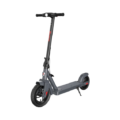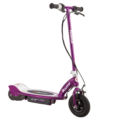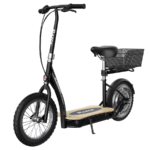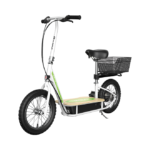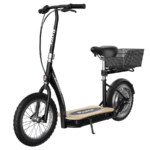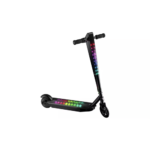- Home
- Scooters
- Electric Scooters
- Razor EcoSmart Cargo
Razor EcoSmart Cargo
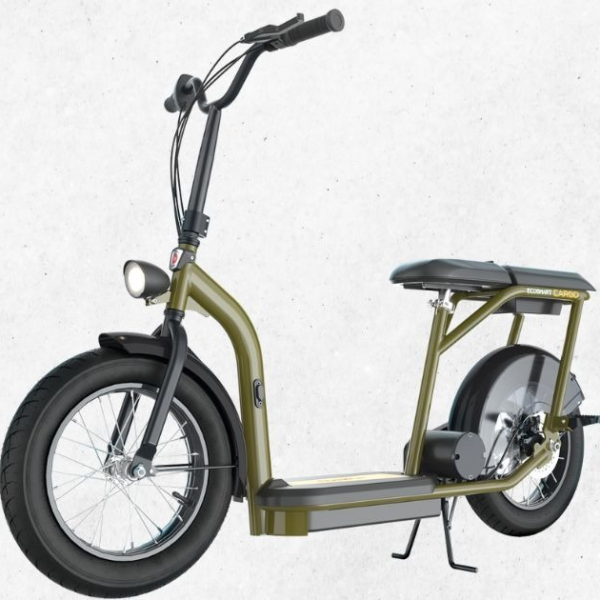

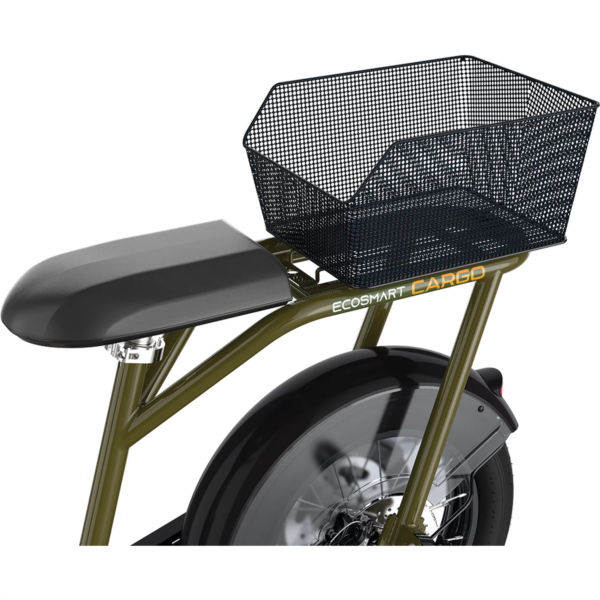
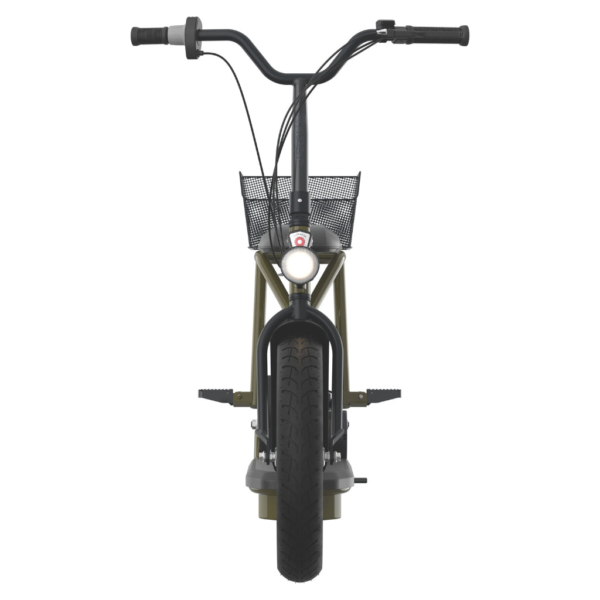
- Battery Range: 16 mi (26 km)
- Top Speed: 20 mph (32 km/h)
- Motor Power: 500–750 W nominal (region-dependent)
- Weight Capacity: 265 lb (120 kg)
- Charging Time: ~7–8 h
- Scooter Weight: 75.0 lb (34.0 kg)
PROS
- Rack + modular seat for cargo
- Stable long-wheelbase handling
- 16″ pneumatic tires for comfort
- Bright lighting + strong visibility
- Higher-capacity battery for errands
CONS
- Heavier to carry upstairs
- Needs larger storage space
- Pneumatics require pressure checks
- Top speed capped for safety


Table of contents
- What Is the Razor EcoSmart Cargo?
- How the Razor EcoSmart Cargo Works
- Key Specifications (clean table)
- Design & Build Quality
- Performance Fundamentals
- Battery, Range & Efficiency
- Ride Quality & Comfort
- Braking & Safety Features
- Portability & Daily Usability
- Maintenance & Care
- Weather & Seasonal Considerations
- Razor EcoSmart Cargo vs Alternatives
- Who the Razor EcoSmart Cargo Is (and Isn’t) For
- FAQs
- Glossary
- Final Take
The Razor EcoSmart Cargo is a seated, utility-focused electric scooter built for everyday errands and short commutes. It favors stability and cargo capacity over flashy speed. As a result, it suits beginners who want an easy, predictable ride and experienced riders who value comfort and load-carrying more than raw performance. If you’re also considering a nimble stand-up alternative, see our balanced MAXSHOT X1 review for a commuter benchmark.
What Is the Razor EcoSmart Cargo?
At its core, the Razor EcoSmart Cargo is a sit-down electric scooter with large, bicycle-style wheels and a modular rear rack system. Unlike many stand-up models with narrow decks, this platform offers a seated posture, a broad deck for your feet, and room for bags or a small crate. Consequently, it reduces fatigue, improves balance at low speed, and turns “quick errands” into genuinely simple rides.
Moreover, the scooter’s calm geometry promotes confidence. You mount it like a compact bike, settle onto a cushioned saddle, and roll away with smooth electric assist. Additionally, the big pneumatic tires glide over cracks and seams that would upset smaller wheels. For new riders, that combination feels reassuring. For returning riders, it delivers a practical neighborhood runabout that is easy to park and easy to maintain.
How the Razor EcoSmart Cargo Works
Motor. A rear-wheel hub motor provides quiet, low-maintenance propulsion. Because the motor sits inside the wheel, there are no chains or belts to adjust. Twist the throttle and torque arrives immediately; ease off and speed tapers predictably. Therefore, starts feel controlled rather than jumpy.
Controller. The controller is the scooter’s “brain.” It translates throttle input into measured current, protects the battery, and smooths acceleration. In effect, it acts like a helpful chaperone between your hand and the motor. Consequently, even new riders can hold steady speeds and avoid lurchy takeoffs.
Battery. The battery stores the energy you spend on starts, hills, and cruising. Since multi-cell packs behave differently with temperature, the scooter feels strongest in mild or warm weather and slightly softer in the cold. Even so, the output remains consistent enough for typical neighborhood use.
Throttle. The twist or thumb throttle functions like a volume knob for speed. Turn a little for mellow roll-off; turn more for assertive acceleration. With practice, most riders develop a smooth rhythm: roll on to reach a target pace, then relax to maintain it. Consequently, range and comfort both improve.
Brakes. Cable-actuated disc braking at the rear delivers a firm, predictable bite. Squeeze lightly to scrub speed; squeeze halfway for decisive deceleration; squeeze fully for strong stops. Meanwhile, shifting your weight rearward during hard braking shortens stopping distance and stabilizes the chassis.
Key Specifications (clean table)
Note: Model-year configurations can vary by region. The table below focuses on defining traits rather than precise numeric ratings.
| Category | Details |
|---|---|
| General | Seated utility scooter; large bicycle-style wheels; broad deck; rear cargo rack with basket/attachment options; cushioned saddle. |
| Performance & Power | Rear hub motor tuned for neighborhood speeds; smooth, linear throttle response; torque suited for stop-and-go city riding; steady hill pace on moderate grades with rider weight affecting results. |
| Battery, Charging & Electrical | Integrated multi-cell battery pack; frame-mounted charge port; basic charger included; onboard battery management to protect cells; charge indicator on cockpit or charger. |
| Build & Dimensions | Robust steel frame with long deck platform; seat height set for relaxed posture; wheelbase sized for stability; folded dimensions: not applicable (fixed frame; does not fold). |
| Safety & Control | Rear mechanical disc brake; large pneumatic tires for grip and bump absorption; reflectors; front headlight and rear tail/brake light; audible bell/horn depending on region. |
| Features & Extras | Modular rear rack; compatible basket/crate options; passenger-support accessories may be available in some regions; basic display or indicator cluster; Cruise Control: typically not included. |
| Warranty & Compliance | Limited consumer warranty typical for small electric vehicles; regional compliance varies; follow local e-mobility and helmet guidance. |
Design & Build Quality
Frame and deck. The EcoSmart Cargo’s steel frame prioritizes stiffness and load support. Consequently, the scooter feels planted when you add a basket or crate. The long deck offers natural foot placement and room to shift on longer rides. Furthermore, steel construction anchors bolts securely and welcomes accessories without fuss.
Seat and cockpit. The saddle balances cushion with firmness. For most riders, it remains comfortable for 10–30-minute trips. The cockpit favors simplicity: a left brake lever, a right-side throttle, and a small display or indicator cluster. Because the layout is minimal, the learning curve stays short and distractions remain low.
Fit-and-finish. Practical details stand out. Cable routing avoids snags. Rack mounts align square, so baskets sit straight. Paint and hardware lean utilitarian rather than flashy; however, the presentation looks tidy and wears everyday use well. As a result, the scooter feels ready for work rather than weekend show.
Performance Fundamentals
Acceleration feel. Off the line, the EcoSmart Cargo prefers smooth, progressive launches. Roll on gently and it gathers speed without drama. Therefore, stop-sign starts feel predictable, and merging into neighborhood traffic happens calmly.
Cruising stability. Large wheels matter. Compared with tiny-wheel stand-up scooters, this platform tracks confidently over joints and pothole edges. Additionally, the longer wheelbase helps the chassis stay composed when you stand briefly to stretch. As long as weight stays centered, the scooter remains calm.
Hill behavior. On rolling terrain—roughly 7–10% grades—expect steady climbs with modest loads. Heavier riders or full baskets slow the pace, yet the scooter still ascends predictably when you carry a bit of momentum. Consequently, route planning pays off: string together gentler inclines and avoid stopping mid-hill when possible.
Battery, Range & Efficiency
Rated vs real-world range. Range is a moving target. Temperature, wind, surface roughness, tire pressure, rider weight, and stop-and-go patterns all matter. In warm weather on flat ground, you’ll see your best mileage at a moderate cruising speed. Conversely, cold days, hills, and heavy cargo reduce range.
How to ride efficiently. Smoothness wins. Instead of full-throttle blasts, roll on gently and cruise at a sensible pace. In addition, keep tire pressures within the recommended window so the tires roll freely. When possible, choose slightly longer but flatter routes to avoid long uphill drags with cargo.
Charging best practices. After a ride, let the battery cool to room temperature before charging. Then charge in a dry, ventilated space away from direct sun. For daily use, topping up near full before a commute is fine. However, for storage periods longer than a couple of weeks, leave the battery around mid-charge in a cool, dry place. Avoid routine deep discharges; they strain cells and shorten long-term health.
Weather effects. Heat boosts chemical activity, so performance feels a touch stronger on hot days, though high temperatures age cells faster. Conversely, cold thickens internal resistance and softens acceleration. Therefore, expect a quieter launch and plan extra capacity in winter.
Ride Quality & Comfort
Tire type. The EcoSmart Cargo rides on large pneumatic tires. Because air cushions bumps and extends contact time, sharp hits feel muted and traction improves on rough pavement. Nevertheless, inflated tires need attention. Check pressures weekly. Underinflation invites sluggish steering and pinch flats; overinflation reduces grip and comfort.
Suspension behavior. This model relies on tire volume, wheelbase, and frame tuning instead of complex suspension. Consequently, maintenance stays simple while comfort remains solid for city streets. On broken surfaces, stand briefly and use your legs as springs. Meanwhile, the stable platform makes those moments easy.
Ergonomics and stem flex. The seated posture keeps your center of mass low and reduces wrist fatigue. Handlebar reach feels neutral for most riders under about 6’2”. Stem flex is mild under normal loads, which helps absorb buzz without feeling vague. Even so, taller riders carrying heavy cargo may notice slightly more bar movement over abrupt edges; it stays within normal limits for this class.
Braking & Safety Features
Brake system. A rear mechanical disc brake offers predictable, progressive bite. Typically, engagement firms up around half-lever travel. For everyday stops, a steady squeeze works well. However, for emergency braking, apply more pressure while shifting weight rearward. Consequently, traction grows and stopping distances shrink.
Lighting and visibility. A front headlight improves conspicuity at dusk, while a rear tail/brake light announces deceleration. Side reflectors and tire or frame accents improve cross-traffic visibility. Additionally, adding reflective bands or a bright jacket helps drivers pick up your motion cues at night.
Water and dust. The scooter tolerates light splashes, yet extended riding in heavy rain is not advised. Water can affect bearings, connectors, and brake performance. If you get caught in a storm, dry the scooter afterward, paying attention to the underside of the deck, rack mounts, and the caliper area. As a result, corrosion risk drops and braking stays consistent.
Riding habits. Keep two fingers near the brake lever in busy areas. Look far ahead for driveways and opening car doors. Because smaller wheels roll over obstacles less easily than full-size bicycle wheels, leave extra following distance and square up to curbs or seams you must cross.
Portability & Daily Usability
Weight and carrying. The EcoSmart Cargo prioritizes stability and cargo capacity, so it weighs more than most stand-up commuters. Therefore, daily stair carries are not ideal. Instead, plan ground-level parking in a sheltered spot, or roll it into a garage nook or storage shed.
Fold mechanism. There isn’t one. The fixed frame boosts stiffness and durability. If you need to transport the scooter by car, remove loose accessories, open the hatch, and lift with your legs while supporting the rack. Alternatively, a small hitch platform or van bed simplifies longer trips.
Storage and security. Store indoors when possible. If you must park outside briefly, lock the frame to a fixed object with a stout U-lock or hardened chain. Moreover, remove quick-release baskets and valuables. Because visibility deters theft, choose bright, well-traveled locations and avoid leaving the scooter out overnight.
Maintenance & Care
Tire pressure. Check weekly with a reliable gauge. Proper pressure sharpens steering, protects range, and prevents rim strikes. Consequently, ride quality improves and flats become less likely.
Brake adjustment. As pads bed in, lever throw may grow. Use the barrel adjuster or cable clamp to restore a firm engagement point. If the rotor rubs, center the caliper. Replace pads when material thins or braking stays noisy even after cleaning.
Fastener checks. Vibrations work on bolts. Every month, tour the scooter with 4/5/6 mm hex keys and a small torque wrench. Rack mounts, caliper bolts, handlebar clamp, and axle hardware deserve extra attention. With a five-minute check, you prevent rattles and preserve alignment.
Electrical habits. Keep the charge port cap clean and seated. If the charger plug looks dusty, blow it out gently before connecting. Charge in a cool area and avoid parking the battery at 100% for long periods when you will not ride soon.
Simple schedule.
- Weekly: tire pressure, quick visual for loose bolts, brake feel check.
- Monthly: fastener tour, pad/rotor inspection, cable lubrication at lever pivots if needed.
- Seasonal: deep clean, contact-point inspection, battery health review (watch range trends), tire replacement when tread or sidewalls age out.
Weather & Seasonal Considerations
Rain. Wet roads reduce traction. Therefore, brake earlier, modulate gently, and stay upright over paint lines and metal plates. After a rainy ride, dry the scooter and gently pump the brakes while rolling to wipe the rotor. Consequently, pad surfaces clean up faster.
Heat. In hot weather, the system may feel livelier, yet batteries age faster at high temperatures. Park in the shade when you can. Additionally, after long uphill sections with cargo, give the scooter a short cool-down before plugging in.
Cold. Lower temperatures trim range and soften off-the-line punch. Start each winter ride with a gentle minute to warm the system under light load. Also, remember that cold drops tire pressure; check it more often in winter.
Wind. Headwinds reduce range quickly. Thus, ride a touch slower and keep your elbows tucked. Tailwinds, by contrast, are free help—enjoy them while staying within safe speeds.
Razor EcoSmart Cargo vs Alternatives
Versus lightweight stand-up commuters. The EcoSmart Cargo wins on comfort, stability, and cargo utility. Larger wheels, a seated posture, and a rack system make errands easy. However, it is heavier and non-folding, so train riders and walk-up apartment dwellers may prefer a lighter folding model.
Versus performance stand-ups. High-powered stand-ups sprint harder and reach higher top speeds. Even so, they often sacrifice cargo utility and beginner-friendly manners. If you value easy starts, predictable turning, and calm cruising, the EcoSmart Cargo remains the more sensible pick.
Versus full moped-style e-bikes. Mopeds add range and two-person seating, yet they are larger, pricier, and heavier to maneuver. By contrast, the EcoSmart Cargo offers much of a moped’s comfort with the smaller footprint and simpler care of a scooter. Consequently, it fits urban errands without demanding moped-level storage space.
Where the EcoSmart Cargo excels. Short city loops, grocery runs, campus moves, and relaxed commutes. It shines when frequent stops, low-speed control, and cargo convenience matter more than outright pace.
Who the Razor EcoSmart Cargo Is (and Isn’t) For
Ideal for:
- Commutes under 10 miles round-trip. You get a comfortable seated ride with steady range, and the rack handles a backpack or lunch bag. Moreover, the calm throttle reduces fatigue in traffic.
- Students and campus staff. Smooth speed control, big wheels for cracked paths, and stable parking make it easy to live with between classes or buildings.
- Errands and last-mile riders. The rack turns grocery runs into simple tasks. Instead of balancing a bag on the bars, you secure it in a basket and ride more safely.
- New riders. The seated posture and linear throttle reduce the learning curve. Consequently, first rides feel approachable rather than intimidating.
Probably not for:
- Multi-modal travelers who must carry the scooter. Stairs, subways, and bus transfers favor a lighter folding platform. Therefore, consider a compact commuter if you haul often.
- Speed chasers. If your goal is high-20s or 30+ mph thrills, a performance stand-up with stronger brakes and suspension fits better.
- Technical trail riders. The EcoSmart Cargo targets pavement and packed paths. For rough off-road, choose a suspension model with knobby tires and wider bars.
FAQs
1) How fast does it feel in everyday use?
It feels brisk enough for neighborhood traffic, bike paths, and campus routes. Acceleration is smooth rather than aggressive; therefore, control stays easy.
2) How far can I ride on one charge?
Range depends on rider weight, terrain, speed, and temperature. Gentle riding on flat ground in mild weather yields the best results; conversely, cold, hills, and heavy cargo trim range.
3) Can it climb hills?
Yes, on moderate grades. Maintain momentum and avoid stopping mid-slope. With heavier loads, expect slower speeds; however, climbs remain predictable.
4) What maintenance should I expect?
Keep tires inflated, check bolts monthly, and adjust the brake as pads bed in. Additionally, dry the scooter after rainy rides and charge the battery in a cool space.
5) Does it have cruise control?
Typically, no. The platform emphasizes direct control. Consequently, you set speed with your wrist and keep attention on the road.
6) Is there a “Razor EcoSmart Cargo overview” I can read quickly?
Yes. This article serves as that quick overview, focusing on real-world use, care, and suitability without hype.
7) Can I carry groceries or a backpack?
Absolutely. The rear rack supports baskets or crates, which is safer than hanging bags from the bars. As a result, balance improves and steering stays lighter.
Glossary
Amp-hour (Ah). A measure of battery capacity; higher Ah usually means more stored charge.
Watt-hour (Wh). Battery energy (volts × amp-hours); more Wh often equals more range.
Controller. Electronics that meter power to the motor and smooth acceleration.
Hub motor. A motor built into the wheel hub; quiet, sealed, and low-maintenance.
Torque. Rotational force from the motor; more torque improves starts and hills.
Voltage (V). Electrical “pressure”; higher voltage can feel peppier at the same current.
Current (A). Electrical flow; more current produces stronger acceleration but increases draw.
Regen (regenerative braking). Motor-based braking that can return a little energy to the battery.
Stem flex. Small elastic movement felt at the bars; mild flex reduces buzz.
IP rating. Ingress Protection for dust/water; many scooters are splash-tolerant, not submersible.
Pneumatic tire. Air-filled tire that cushions bumps and improves grip versus solid rubber.
Mechanical disc brake. Cable-actuated disc system with predictable engagement and simple service.
Wheelbase. Distance between wheel centers; a longer wheelbase increases stability.
BMS (Battery Management System). Electronics that protect cells from harmful conditions.
State of charge (SoC). Remaining battery percentage; mid-range storage is gentler long-term.
Final Take
The Razor EcoSmart Cargo leans into daily usefulness: stability, comfort, and cargo capacity. It will not set speed records, and it does not fold; however, it handles commutes, errands, and campus loops without drama. The seated posture eases fatigue. The big tires calm broken pavement. Meanwhile, the rack turns awkward loads into simple trips. Keep the tires inflated, check bolts monthly, and charge thoughtfully. Do that, and the EcoSmart Cargo becomes a low-stress way to shrink your everyday radius and park the car more often.
Specifications
General
| Model The Model specifies the exact version or name of the scooter. It helps identify its unique design, features, and specifications within the manufacturer’s product line. Knowing the model makes it easier to compare options, find compatible accessories, or look up support information. | EcoSmart Cargo |
| Brand The Brand identifies the manufacturer or company that designs and produces the scooter. A trusted brand is a sign of quality, reliability, and good customer support. Well-known brands often have higher standards for safety, performance, and after-sales service, giving you more confidence in your purchase. | Razor |
| Release Date The Release Date indicates when the scooter model was officially launched on the market. This helps you know how current the design, technology, and features are. A newer release date often means updated components, improved performance, and the latest safety or smart features. | 17 November 2025 |
| Recommended Age Recommended Age indicates the minimum age range that the scooter is designed for, based on safety, size, and ease of use. Following the recommended age helps ensure that riders can handle the scooter’s speed, weight, and controls comfortably and safely. Always check local laws and use protective gear, especially for younger riders. | Recommended 16+ |
Performance & Power
| Motor Power (Wattage) What it means: The motor power, measured in watts (W), shows how strong the scooter’s electric motor is. Why it matters: Higher wattage usually means better acceleration, more torque, and improved performance on hills or rough terrain. For example, a 250W motor is good for flat city roads and light riders, while a 500W or 1000W motor provides more power for faster speeds or climbing steep inclines. | 500–750 W nominal |
| Top Speed The Top Speed indicates the maximum speed that the scooter can reach under optimal conditions. It’s usually measured on level ground with a fully charged battery and an average rider weight. A higher top speed allows you to travel longer distances faster, but always ensure you ride within legal speed limits and your personal comfort zone for safety. | 20 mph (32 km/h) |
| Battery Capacity Battery Capacity refers to the total amount of energy the scooter’s battery can store, usually measured in ampere-hours (Ah) or watt-hours (Wh). A higher battery capacity means you can ride longer distances on a single charge, reducing the need for frequent recharging. Keep in mind that actual range can vary depending on rider weight, terrain, speed, and weather conditions. | 48 V 12 Ah |
| Estimated Range per Charge The Estimated Range per Charge indicates the average distance the scooter can travel on a single full battery charge. This range is calculated under optimal conditions, such as flat terrain, moderate speed, and average rider weight. Real-world range may vary depending on riding style, terrain, weather, and load. A longer range means fewer recharges and greater freedom for longer trips. | Up to 16 mi (26 km) |
| Hill Climb Ability Hill Climb Ability describes the maximum incline or slope that the scooter can handle while maintaining stable performance. It’s typically expressed as a percentage or in degrees. A higher hill climb rating means the scooter can tackle steeper hills without losing too much speed or power. Actual climbing performance may vary based on rider weight, battery charge, and terrain conditions. | Up to 15° grades |
| Drive System The Drive System refers to how power from the motor is delivered to the wheels. Electric scooters typically use either a hub motor (directly integrated into the wheel) or a chain/belt drive system. A high-quality drive system ensures smooth acceleration, efficient power transfer, and low maintenance. The choice of drive system affects performance, noise level, and overall ride experience. | Rear hub motor (RWD) |
Charging & Electrical
| Charging Time Charging Time indicates how long it takes to fully recharge the scooter’s battery from empty to 100% using the standard charger provided. Faster charging means less downtime and more time on the road. Actual charging time may vary slightly depending on battery capacity, charger output, and environmental conditions. | Approx. 7–8 hours |
| Battery Type Battery Type refers to the specific technology used in the scooter’s battery, which affects performance, lifespan, weight, and charging time. Most modern electric scooters use high-quality lithium-ion (Li-ion) batteries because they offer a good balance of energy density, durability, and low maintenance. A reliable battery type ensures consistent power delivery and longer riding ranges. | Li-ion with Smart BMS |
| Removable Battery A Removable Battery means the battery pack can be easily detached from the scooter for convenient charging and replacement. This feature allows you to charge the battery separately, swap it with a spare for extended range, or securely store it indoors in extreme weather. Removable batteries add flexibility and make it easier to keep your scooter powered up wherever you are. | No external fast charge |
| Regenerative Braking Regenerative Braking is an energy-saving feature that converts some of the energy normally lost during braking back into battery power. When you slow down or brake, the motor works in reverse to generate electricity, which helps extend the scooter’s range and improves overall efficiency. This system also reduces wear on traditional brake components, leading to lower maintenance over time. | Electronic assist + mechanical brake |
| Lighting Lighting refers to the built-in front and rear lights that enhance visibility and safety when riding in low-light conditions or at night. Good lighting helps you see the road ahead and ensures that other road users can see you. Many scooters include LED headlights, taillights, and sometimes brake lights or side reflectors for added safety and compliance with local traffic regulations. | Headlight + tail/brake + reflectors |
Build & Dimensions
| Scooter Weight Scooter Weight refers to the total weight of the scooter when fully assembled, including the battery. This affects how easy it is to carry, lift, and store the scooter when not in use. A lighter scooter is more portable and convenient for commuting, especially if you need to carry it upstairs or onto public transport. Keep in mind that a sturdy frame and quality components may add to the weight but also contribute to better durability and ride stability. | 75.0 lb (34.0 kg) |
| Maximum Rider Weight Maximum Rider Weight indicates the highest rider weight that the scooter is designed to safely support while maintaining optimal performance and stability. Staying within this limit helps ensure reliable acceleration, braking, and climbing ability, and it protects the frame, suspension, and motor from excessive strain. Exceeding the recommended limit may reduce performance and increase wear on components. | 265 lb (120 kg) |
| Deck Size Deck Size refers to the dimensions of the scooter’s standing platform. A wider and longer deck provides more foot space, allowing you to stand comfortably and adjust your stance while riding. A well-sized deck improves balance and stability, especially on longer rides or at higher speeds. Compact decks, on the other hand, help keep the scooter lightweight and portable. | Cargo-friendly rack; seated geometry |
| Handlebar Height Handlebar Height refers to the distance from the deck to the handlebars, which affects your riding posture and comfort. An appropriate handlebar height helps you maintain good balance, reduces strain on your back and arms, and makes steering more comfortable. Some scooters have adjustable handlebars to fit riders of different heights, while others have a fixed height for a streamlined design. | Comfort bar height |
| Folding Mechanism The Folding Mechanism describes how easily and securely the scooter can be folded for carrying and storage. A well-designed folding system lets you quickly collapse the scooter into a compact size, making it convenient to transport on public transit, store under a desk, or fit into a car trunk. Look for sturdy latches and safety locks to ensure the scooter stays firmly in place when folded or unfolded. | Folding stem (seat/rack fixed) |
| Dimensions Folded Dimensions indicate the size of the scooter when it’s fully folded. This measurement shows how much space the scooter will take up when stored or carried, making it easier to check if it will fit in your car trunk, under a desk, or in a closet. Compact folded dimensions are ideal for commuters who need to bring their scooter on public transport or store it in tight spaces. | 58.0 × 26.0 × 26.0 in (folded) |
| Material Material refers to the primary construction materials used for the scooter’s frame and key components. High-quality materials like aircraft-grade aluminum, reinforced steel, or durable composites provide strength, stability, and a lighter overall weight. A sturdy material ensures the scooter can handle daily wear and tear while maintaining safety and performance. | Steel/aluminum mix |
Safety & Control
| Brake Type(s) Brake Type(s) describe the braking systems the scooter uses to help you slow down or stop safely. Common brake types include mechanical brakes (like drum or disc brakes), electronic brakes, and foot brakes. Many scooters combine multiple braking systems for added safety and shorter stopping distances. The type and quality of brakes affect your control, especially when riding at higher speeds or on slopes. | Rear mechanical brake + e-assist |
| Suspension Suspension refers to the system that absorbs shocks and vibrations while riding, providing a smoother and more comfortable ride over uneven or rough surfaces. Scooters may have front suspension, rear suspension, or dual suspension for better shock absorption and stability. Good suspension helps reduce rider fatigue and improves control, especially when riding on bumpy roads or off-road paths. | Front fork + rear spring |
| Tire Type Tire Type refers to the kind of tires the scooter uses, which directly affects ride comfort, traction, and maintenance. Common types include solid (airless) tires, pneumatic (air-filled) tires, or hybrid options. Pneumatic tires offer better shock absorption and a smoother ride on rough surfaces, while solid tires are puncture-proof and require less upkeep. The right tire type helps ensure safe handling and a comfortable ride in different conditions. | Pneumatic street tires |
| Tire Size Tire Size indicates the diameter and width of the scooter’s tires, which affect ride comfort, stability, and how well the scooter handles different terrains. Larger tires generally offer better shock absorption and a smoother ride over bumps and rough surfaces, while smaller tires keep the scooter lighter and more portable. Choosing the right tire size helps ensure a balance between agility and comfort. | 16-inch |
| Kickstand The Kickstand is a built-in stand that allows you to park your scooter upright when it’s not in use. A sturdy kickstand keeps the scooter stable and prevents it from tipping over, protecting it from scratches and damage. It also makes storing and accessing your scooter more convenient, whether you’re at home, work, or on the go. | Side kickstand |
| Water Resistance Rating Water Resistance Rating indicates how well the scooter is protected against water and moisture, usually shown as an IP (Ingress Protection) rating. This rating helps you understand whether the scooter can handle light rain, splashes, or wet roads without damage. While most scooters are not fully waterproof, a good water resistance rating adds peace of mind when riding in changing weather conditions. Always avoid deep puddles or submerging the scooter to protect its electrical components. | IPX4 body |
Features & Extras
| Display/Console The Display (or Console) shows important real-time information about your ride, helping you monitor your scooter’s status at a glance. Typical displays show speed, battery level, distance traveled, and riding mode. Some models also include additional features like Bluetooth connectivity, app integration, or backlighting for better visibility at night. A clear and easy-to-read display enhances safety and convenience on every trip. | LCD dashboard |
| Ride Modes Ride Modes refer to the different speed and power settings you can choose to match your riding style or road conditions. Common modes include eco for maximum range and energy efficiency, standard for everyday balance, and sport or turbo for higher speed and stronger acceleration. Switching between ride modes allows you to customize performance, conserve battery, and ride safely in various environments. | Eco, Drive |
| Smart App Connectivity Smart App Connectivity lets you pair your scooter with a dedicated mobile app via Bluetooth. Using the app, you can monitor real-time ride stats like speed, battery level, and range, adjust settings such as ride modes or cruise control, lock the scooter for added security, and sometimes receive firmware updates. This feature adds convenience and allows you to personalize your riding experience right from your smartphone. | App-free basic operation |
| Anti-Theft System The Anti-Theft System helps protect your scooter from unauthorized use or theft. This feature can include built-in alarms, electronic motor locks, GPS tracking, or remote locking through a mobile app. A good anti-theft system provides peace of mind when parking your scooter in public spaces, adding an extra layer of security to safeguard your investment. | N/A |
| Cruise Control Cruise Control allows you to maintain a steady speed without continuously holding the throttle. This feature makes longer rides more comfortable by reducing hand fatigue and providing a smoother, more relaxed riding experience — especially on flat, open roads or bike lanes. For safety, cruise control can usually be easily activated or deactivated while riding. | No (region-dependent) |
| Accessories Included Accessories Included lists the additional items that come with the scooter to enhance your riding experience and convenience. Common accessories may include a charger, kickstand, bell, lights, phone holder, or carrying strap. These extras add value by making your scooter safer, easier to use, and ready to ride straight out of the box. | Bell, reflectors, charger |
Warranty & Compliance
| Warranty Period The Warranty Period indicates how long the manufacturer guarantees the scooter against defects in materials and workmanship under normal use. A good warranty provides peace of mind, showing the brand’s confidence in its product quality. Always check what parts are covered, such as the frame, battery, and motor, and follow the maintenance guidelines to keep your warranty valid. | 12 months typical |
| Certifications Certifications confirm that the scooter meets specific safety, quality, and environmental standards set by recognized organizations or regulatory bodies. Common certifications may include CE, RoHS, UL, or other local compliance marks, depending on your region. These certifications ensure that the scooter is manufactured to high standards and is safe and legal to use in your country. | Local e-scooter compliance |
Price Comparison




